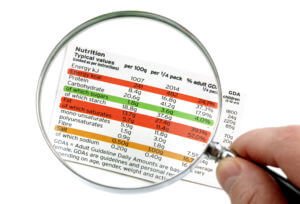Evidence Update: New Food Labels for 2018

On May 20, 2016, the FDA announced that there will be a new Nutrition Facts label for packaged foods. This new label will reflect new scientific information, including the link between diet and chronic diseases such as obesity and heart disease. The intent of the new label is to make it easier for consumers to make better-informed food choices. The new label is set to launch January 2018, but you may have already seen it on some of your favorite foods. Compliance date is set for July 26, 2018, with an additional year to comply for manufacturers with annual food sales of less than $10 million. The significant changes include: Serving size and serving per container: The number of “servings per container” and the “serving size” have changed. They now reflect what people actually eat and drink rather than what is recommended. For instance, a recommended serving size of ice cream is ½ cup, but, on the new label serving sizes with be more realistic and will reflect what people typically eat at one serving which is 2/3 cup. Calories: Calorie listed will be in a larger and bolder type. Calories from Fat: Calories from fat will no longer be listed. Research shows the type of fat consumed is more important than the amount. Added sugar: Finally added sugars will be required on all food labels. “Added Sugars” in the form of grams and as a percent Daily Value (%DV) is now required on the label. “Added Sugars” include sugars that have been added during the processing or packaging of a food. Scientific data shows that it is difficult to meet nutrient needs while staying within calorie limits if you consume more than 10 percent of your total daily calories from added sugar. Potassium and Vitamin D: The lists of nutrients that are required or permitted on the label have been updated. Vitamin D and potassium are now required on the label because Americans don’t always get the recommended amounts. No longer will Vitamins A and C be listed on the label since deficiencies of these vitamins are rare today. The actual amount (in milligrams or micrograms) in addition to the %DV must be listed for vitamin D, calcium, iron, and potassium. The daily values for nutrients have also been updated based on newer scientific evidence. The daily values are reference amounts of nutrients to consume or not to exceed and are used to calculate the %DV. Footnote: The footnote at the bottom of the label has changed and will better explain the meaning of %DV. The %DV is listed to help you understand the nutrition information in the context of a total days’ worth of eating. For more details, check out the FDA Information: https://www.fda.gov/Food/GuidanceRegulation/GuidanceDocumentsRegulatoryInformation/LabelingNutrition/ucm385663.htm#dates
Patient Perspective: Jean

I know what you’re saying – – – what was she thinking??? It was inevitable that I was going to lose my hair so I decided to have a little fun with it and a hot pink Mohawk for my three granddaughters was just what the doctor ordered. They said they had the “Coolest” Grandma alive. I tried to keep this positive attitude throughout my chemo, radiation and surgery. My first visit to TurningPoint was an eye-opener. I did not have use of my arms and my attitude had begun to falter. TurningPoint took over and lifted me up! Breast cancer changed my life in so many ways. After going through the chemo, surgery and radiation I knew my mind and body would never be the same. That’s where TurningPoint changed my thinking and the way I felt about myself. I look forward to going to TurningPoint because they smile and call me by my first name when I walk in the door. My therapy team, Jyoti and Grayson, worked with me on my specific problem areas and now I have full use of my arms again. They gave me strength training and exercises to do at home which have worked tremendously. My attitude and thinking just got better and better as I went through the program. Now, my motto is this: A lot of women with breast cancer didn’t wake up this morning – but I did. And I thank God every day. In addition to my doctors, family and friends, TurningPoint has made a HUGE difference in my recovery – they gave me back my life.
Evidence Update: Journaling and Breast Cancer Patients

Journaling can be a powerful tool to improve quality of life, fatigue, and post-traumatic stress among breast cancer patients. A recent research study had a group of women with breast cancer write about their breast cancer journey. The study revealed 3 common themes in these women’s experience: writing as process, writing as therapeutic, and writing as a means to help others. Writing gives us a way to tell our story by reflecting on experiences, choices, and obstacles we have overcome. The research also points out that at times our writing is for ourselves, but it can also be an avenue to help others if we so desire. This study also found expressive writing to be a venue for releasing cognitive, relational, and emotional strains. Instead of holding these stressors inside of our bodies, writing provides us a way to let go of the stress and have it reside in text, allowing us to heal and move forward. Oftentimes when writing, these women viewed parts of their story and their emotions differently, allowing them to process and heal in a new manner. Join us at this month’s community education event to have a time to journal and learn how to easily make journaling part of your journey. Gripsrud et al. Capturing the Experience: Reflections of Women With Breast Cancer Engaged in an Expressive Writing Intervention. Cancer Nursing. 2016 July; 39(4): E51-E60.
Patient Perspective: Kathy

I am what you might call “a late bloomer,” having married for the first time only five years ago at age 62! I married a widower with two grown daughters and three grandchildren. I still work as a Christian Counselor/Therapist, and I enjoy reading, watching and discussing themes in films, and walking. When I was diagnosed with breast cancer it was a real blow. Even though it was only Stage One and I was able to have a successful lumpectomy with clear margins, I went on to suffer for several months with lymph fluid build-up under my right arm. I am right-handed, so the constant swelling, pain and an impingement in my shoulder really hampered my functioning. I was unable to lift with my right arm or even fasten my bra. I had radiation therapy and then a second surgery due to an unforeseen complication. I came across a flyer for TurningPoint and thought that I would try it at least once to see if I could get a bit more freedom of movement. The therapist at TurningPoint did soft tissue massage that really helped with the pain I was experiencing. Then she gave me exercises to do that allowed me to regain my freedom of motion little by little. From time to time I enjoyed a massage that targeted the hurting places in my back and shoulder, and once I sat with a TurningPoint counselor to talk about the impact that the cancer has had on me. All of this has been extremely beneficial, and today I am pain free and able to do everything that I once could do. Occasionally I have some numbness under my arm, and if I’m not careful to exercise I can get a bit stiff on my right side, but I am 100% better after the warm and loving care at TurningPoint. I recommend it to anyone who has breast cancer.










